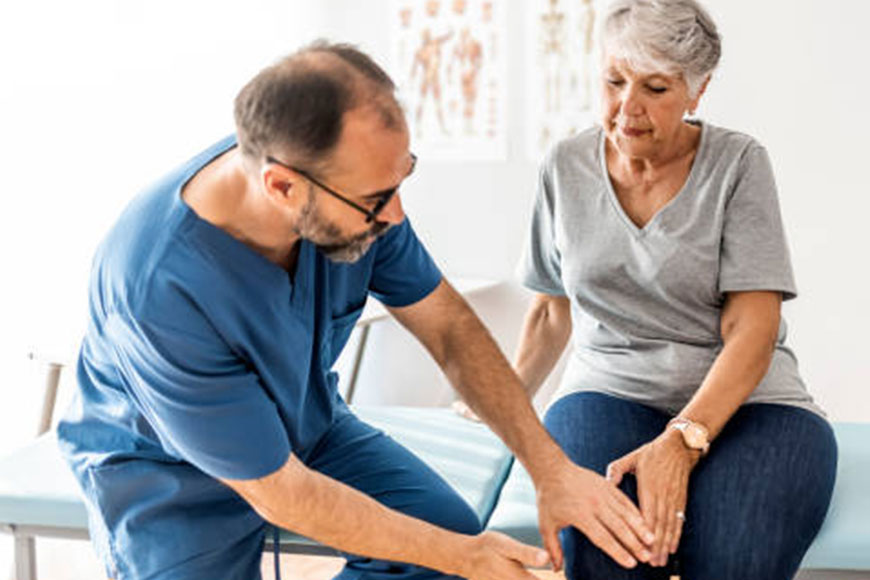
What is knee osteoarthritis?
Osteoarthritis of the knee is a progressive disease caused by inflammation and degeneration of the knee joint that gets worse over time. It affects the entire joint, including the bones, cartilage, ligaments, and muscles. Its progression is influenced by age, body mass index (BMI), bone structure, genetics, muscle strength, and activity level. Knee inflammation may also develop as a secondary condition after a traumatic knee injury. Depending on the stage of the disease and whether there are injuries or concomitant conditions, knee arthritis can be treated with physical therapy.
Symptoms of knee osteoarthritis may include:
- Pain that worsens during or after activity, especially when walking, going up or down stairs, or moving from a sitting to standing position.
- Pain or stiffness after sitting with the knee bent or extended for a long period of time.
- Feeling of the popping, cracking or grinding when moving the knee
- swelling after activity
- Tenderness to touch along the knee joint.
How is it diagnosed?
Knee OA is diagnosed through two basic operations. The first is based on your report of symptoms and a clinical examination. The physical therapist will ask you questions about your medical history and activity. The therapist will perform a physical exam to measure your knee’s motion (range of motion), strength, mobility, and flexibility. You may also be asked to perform different movements to see if they increase or decrease your pain.
The second tool used to diagnose knee osteoarthritis is diagnostic imaging. Your physical therapist may refer you to a doctor, who will order an X-ray of your knee in various positions to check for damage to the bone and cartilage in your knee joint. If more serious joint damage is suspected, an MRI may be ordered to look closely at the general condition of the joint and surrounding tissues. Blood tests may also be ordered to help rule out other conditions that can cause symptoms similar to those of knee arthritis.
How can a physical therapist help?
Once you receive a diagnosis of knee osteoarthritis, your physical therapist will design an individualized treatment program specific to the exact nature of your condition and goals. Your treatment program may include:
Range of motion exercises
Abnormal movement of the knee joint can worsen arthritis symptoms when there is additional stress on the joint. Your physical therapist will evaluate your knee’s range of motion compared to the expected normal motion and knee motion on your uninjured leg. Range of motion exercises will focus on improving your ability to bend and straighten your knee, as well as improving your flexibility to allow for increased mobility.
Muscle strengthening
Strengthening the muscles around your knee will be the essential part of your rehabilitation program. Individuals with knee osteoarthritis who adhere to strengthening programs have been shown to have less pain and an improved overall quality of life. Several factors influence joint health: the quality of the cartilage that lines the bones, the tissues in and around the joints, and the muscles attached to them. Because of the wear and tear on the cartilage associated with osteoarthritis of the knee, maintaining strength in the muscles near the joint is critical to maintaining joint health. For example, because the muscles along the front and back of your thigh (the quadriceps and hamstrings) cross the knee joint, they help control the movement and forces that are applied to the bones.
Strengthening the thigh and torso muscles can also help balance the amount of force on the knee joint, especially while walking or running. The term “cardio” refers to the muscles of the abdomen, lower back, and pelvis. The strong core will increase stability throughout your body as you move your arms and legs. Your physical therapist will evaluate these different muscle groups, compare the strength in each limb, and prescribe specific exercises to target your areas of weakness.
Reciprocal treatment
Physical therapists are trained in the manual (hands-on) therapy. Your physical therapist will gently move your muscles and joints to improve their mobility, flexibility and strength. These methods can target areas that are difficult to treat on your own. Adding manual therapy techniques to exercise plans has been shown to reduce pain and increase function in people with osteoarthritis of the knee.
Preparing
Compression sleeves placed around the knee may help reduce pain and swelling. Devices such as realignment and degassing orthosis are used to modify the forces placed on the knee. These braces can help “unload” specific areas of your knee and transfer contact to less painful areas of the joint during weight-bearing activities. Depending on your symptoms and disabilities, your physical therapist will help you decide which brace may be best for you.
Activity recommendations
Physical therapists are trained to understand how to prescribe exercises for individuals with injuries or pain. Because knee osteoarthritis is a progressive disease, it is important to make a specific plan to do enough activity to treat the problem, while avoiding excessive stress on the knee joint. Activity should be prescribed and monitored based on the type, frequency, duration and intensity of your condition, with adequate time to rest and recover. Research has shown that individuals with osteoarthritis of the knee who walk more steps each day are less likely to develop functional problems in the future. Your physical therapist will consider the stage and extent of your knee OA and prescribe an individualized exercise program to meet your needs and maximize the function of your knee.
